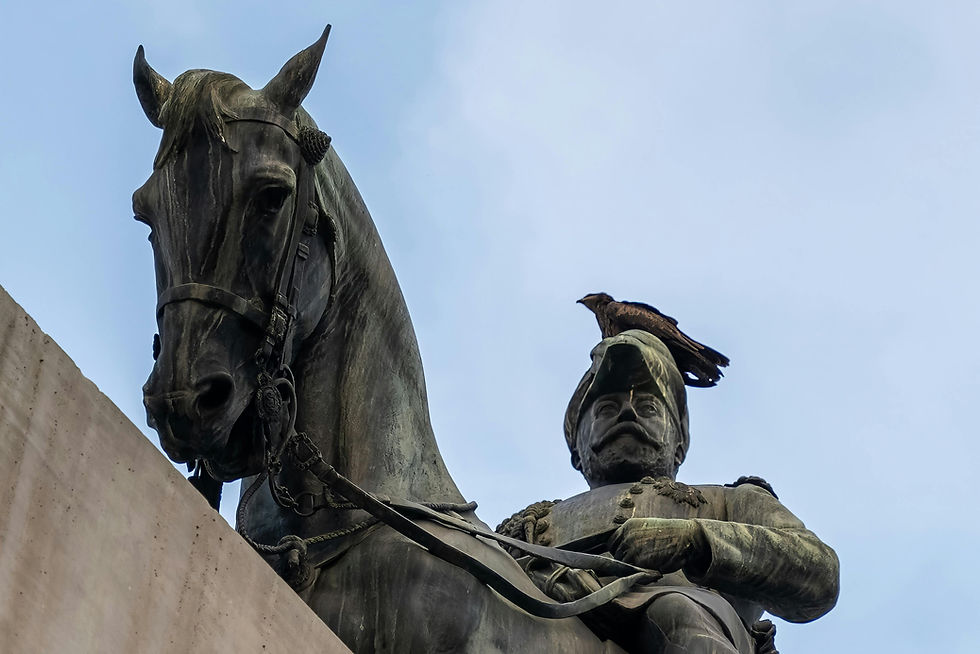The Complete Guide to Protecting Sculptures, Statues, and Artwork from Bird Damage
- Aviaway Bird Blog
- Aug 13
- 4 min read
Updated: Aug 22
Outdoor art is more than decoration, it’s an identity. Public monuments represent history and culture. Corporate sculptures enhance spaces and reinforce brand image. But as beautiful as these installations are, they face a relentless challenge: birds.

Perched on a statue or nested on a sculpture, birds don’t just change the look of a piece. Over time, their droppings, nesting materials, and constant activity cause significant damage. For municipalities and corporations, the choice is clear: protecting outdoor art isn’t optional. It’s a necessary step in preserving value, safety, and beauty.
This guide covers what makes birds such a threat to outdoor art, why proactive preservation matters, and how custom bird control solutions can protect sculptures without compromising their appearance.
The Unseen Threat to Outdoor Art
At first glance, a few birds on a statue may seem harmless. But their impact is far from superficial.
Bird droppings are highly acidic, especially from pigeons and seagulls. Over time, they corrode metal, stain stone, and erode finishes.
Nesting materials jam into crevices, trap moisture, and stain surfaces. They can also clog drains on larger installations.
Constant perching wears down edges, and large flocks can destabilize lightweight structures.
What begins as a cosmetic issue quickly escalates into structural deterioration, and costly restoration.
Why Preservation Matters
Financial impact
Cleaning and restoring outdoor art isn’t cheap. Acidic droppings can etch into bronze, marble, and even painted surfaces. Left untreated, this damage often requires specialized restoration that costs thousands, or even millions, to repair.
Cultural value
Public art is more than an object. It’s a reflection of community identity. Municipal sculptures and monuments are often irreplaceable, and their degradation is a loss shared by everyone.
Brand image
For corporations, a tarnished or stained sculpture sends the wrong message. A weathered installation implies neglect, undermining the professional image that these pieces are meant to convey.
Safety and liability
Bird droppings around sculptures can create slippery surfaces and trip hazards, exposing property owners to legal risks if someone gets hurt.
The bottom line: prevention is far more affordable, and practical, than restoration or legal action after the fact.
Which Birds Cause the Biggest Problems?
Not all birds create the same issues. Understanding their habits helps in designing effective solutions.
Pigeons: The most common culprit. They roost in flocks, leave highly acidic droppings, and nest in any crevice they find.
Starlings and grackles: Known for traveling in large groups, leaving concentrated droppings on sculptures and surrounding walkways.
Seagulls: Common near coastal or waterfront installations, seagulls are messy, aggressive, and persistent.
Identifying which species are affecting your installation is the first step toward solving the problem.
Bird Control Options for Sculptures and Artwork
Every piece of art is unique, which means no single solution works for every project. The most effective bird control plans combine multiple approaches:
Spikes: When used strategically and painted to blend in, spikes can prevent perching without disrupting the piece’s visual integrity.
Fine-wire or grid systems: Tensioned wire creates a barrier that prevents birds from landing but remains nearly invisible from a distance.
Micro-mesh netting: Clear or finely woven netting blocks birds completely while maintaining an unobstructed view of the artwork.
Custom brackets and mounts: For complex shapes or historic pieces, custom-designed hardware ensures secure, non-invasive installation.
Behavior deterrents: Supplemental repellents or sound-based tools can reduce bird activity in high-traffic areas.
Key takeaway: Successful solutions balance effectiveness with aesthetics, ensuring protection doesn’t compromise the art.
Preserving Aesthetics: Keeping Art Beautiful While Protecting It
The challenge for municipalities and corporations isn’t just keeping birds away, it’s doing so without altering the art’s appearance.
Modern solutions are designed to be discreet or nearly invisible. Fine-wire systems disappear against the sky. Netting can be installed with minimal visual impact. Custom hardware can match the color or finish of the sculpture, blending seamlessly into the design.
For historic or culturally significant monuments, consulting with conservation experts is essential. This ensures that bird control methods are reversible, non-invasive, and meet preservation standards.
The Custom Approach: Why Every Project Is Unique
No two sculptures are the same. A historic marble monument in a city square requires different solutions than a modern steel installation on a corporate campus.
A thoughtful approach considers:
Material sensitivity: Bronze, marble, wood, and glass all require unique handling.
Design complexity: Unusual shapes or features may need custom-engineered mounts or brackets.
Location: Urban rooftops, waterfront plazas, and garden courtyards each present unique challenges.
That’s why working with bird control specialists who collaborate with engineers, architects, and art conservators is key. Together, they can design solutions that protect the artwork without leaving a mark.
The Path Forward: How to Protect Your Artwork
If your municipality or organization is managing a public monument, corporate art installation, or historical piece, proactive bird control is the most effective way to ensure long-term preservation.
Here’s how to get started:
Schedule an assessment. A site evaluation helps identify the problem species and the most vulnerable areas of your sculpture.
Develop a tailored plan. Work with professionals who design solutions with aesthetics and material preservation in mind.
Implement custom systems. Use discreet, reversible, and long-lasting bird control installations.
Plan for ongoing care. Regular maintenance ensures your solution stays effective over time.
At AviAway, we specialize in custom, discreet bird control for artwork and sculptures, from historic monuments to modern installations.
If you’re ready to protect your investment without compromising its beauty, get in touch with us today.
Call 844-247-3373 or click here to contact us






























Comments